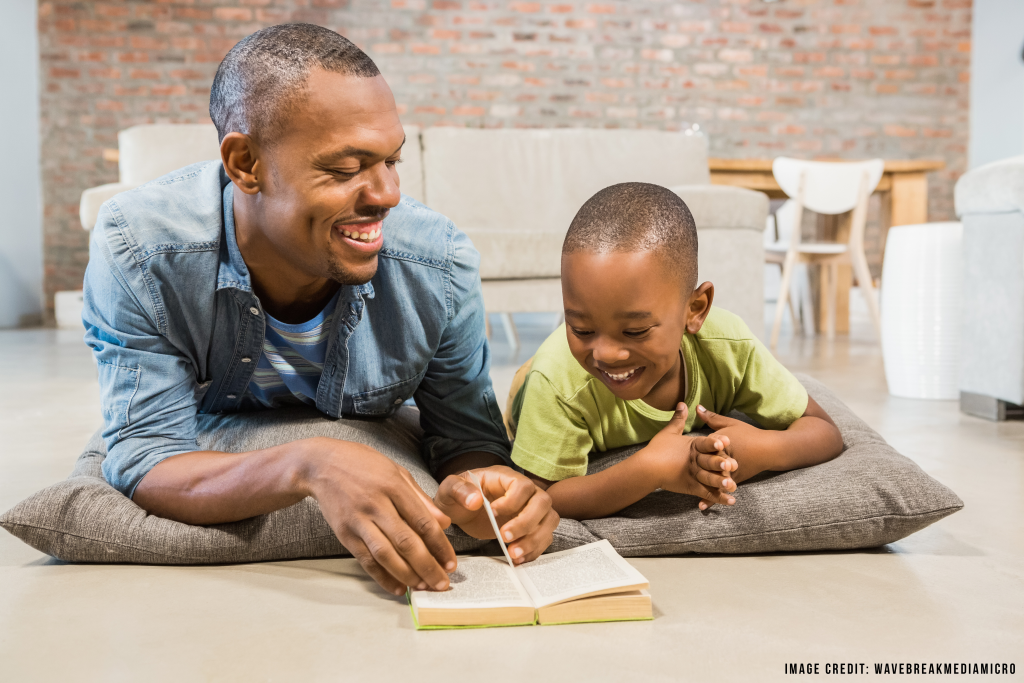For years we’ve known about the literacy gap between children of differing socio-economic backgrounds. We’ve known too that vocabulary acquisition levels are a primary measure of this divide1, 2.
While digital technology makes it easier than ever for children to listen to stories and learn new words on their own, the age-old activity of reading aloud to children — as well as dialoguing about the stories in meaningful ways — may yield a special recipe for improving language and literacy skills in all children.
Reading exposure seems to affect the brain’s “meaning making” centers
The parent-child activity of reading together is believed to foster healthy brain development, vocabulary and language acquisition3. Reading aloud to children regularly from a young age also seems to help them become frequent readers when they are older4.
One of the first studies showing positive correlation between home reading exposure (i.e., reading aloud to children, frequency of reading, access to and types of books, and parent-child interactions) and its affect on the brain was conducted last year by John Hutton, MD, pediatrician and researcher at Cincinnati Children’s Hospital Medical Center 5.
Dr. Hutton and his research team studied 19 preschool students between the ages of three- and five-years. Researchers gave a questionnaire to each child’s parent or provider asking questions about parent-child reading frequency and general home reading exposure. (This measure was used later in the study to determine how children who were read to often differed from those who were not.) The children then underwent fMRI analysis (a method that allows researchers to study activity in the brain based on blood flow) while listening to stories being read to them through headsets. They were not exposed to story illustrations at this time.
The study revealed activation in a couple primary regions, including one called the parietal-temporal-occipital association cortex, an area where meaning is derived from language.
Though the study did not seem to document any language or literacy performance of any kind, it did ascertain that children whose parents reported greater home reading exposure had greater activation in brain regions associated with language comprehension than other children.
Researchers of this study suggest that reading exposure, including reading to children, may help children comprehend language more effectively.
Sparking discussion is key
If home reading exposure correlates with children’s distinct neural processes and may benefit literacy development, do certain factor/s of reading to children make a greater difference?
In 2014, researchers at the University of Maryland developed a study6 to explore whether reading certain book genres to children (i.e., chapter or picture books) or engaging in certain read-aloud strategies are better at “foster[ing] … language and early literary development.”
The study consisted of thirty-three pairs of parents and their preschool-aged children. Participant discussions were observed while parents read to their children a picture book and the first chapter of a chapter book. The researchers were interested in evaluating how parents and their children interacted while reading each type of book.
Interestingly, the study revealed that picture books more than chapter book “elicited greater quantity and quality” of conversation associated with stories read, though both types of books could indeed generate discussion.
What seemed more important to the researchers than book genre, though, was the type of discussions parents engaged in with their children during read-aloud time, since these particular types of conversations have been connected to developing literacy and language skills in young children6.
Strategies for initiating literacy-building discussions
Researchers6 shared several literacy-building conversation strategies adults employed when reading aloud to children:
Connect the book to something in your child’s world
- Ask if your child relates to any character.
- If a character has a hobby, ask your child what his/her hobbies are or what he/ she would like them to be.
- If characters are trying to solve a problem (environmental, friendship, or even pet related) ask about similar concerns in your child’s world.
Talk about something that occurred in the past or will occur in the future
- If a character is having dinner, talk about what your child might like to have for dinner later that day.
- If a book addresses the first day of school, talk to your child about this event in his or her life.
Ask the child to predict what might happen in the book
- What do you think will happen next?
- How do you think this will end?
- Do you think Peter will go back into Mr. McGregor’s garden?
Explain or define something in the text
- Explain a higher-level word your child might not know.
- Explain a challenging or abstract concept with an easy metaphor, image or concrete example from the child’s life or your own life.
- Have the child share what it feels like when he or she is “disappointed” or “jealous.”
The questions in practice
I’ve used questions like these in my educational practice with students of all ages. By reading aloud and dialoguing about what we are reading together, I can see where improvements are needed and ultimately where improvements have occurred.
Through this method, I’ve seen gains in students’ vocabulary acquisition, word pronunciation, background knowledge, and self-knowledge in general.
I’ve also determined how my students are processing information by having them read aloud to me. I’ve recently noticed that one of my middle school students reads too quickly, skipping over or mispronouncing several words per sentence. As a result, he doesn’t always comprehend the material. He is now working on slowing down in order to accurately process what he is reading.
Summary
Though it is still unclear how the various forms of reading exposure prime children’s brains for language and literacy development, research seems to highlight the importance of reading aloud to children and engaging in meaningful conversations stemming from stories they are reading. Future research will tell whether this combo is indeed the secret sauce for generating optimal literacy skills in all children.
References & Further Reading
- Arriaga, R.I., Fenson, L., Cronan, T., & Pethick, S.J. (1998). Scores on the MacArthur Communicative Development Inventory of children from low- and middle-income families. Applied Psycholinguistics, 19: 209-223. [Paper].
- Rich, M. (March 25, 2014). Trying to Close a Knowledge Gap, Word by Word. The New York Times. [Article].
- Rich, M. (June 24, 2014). Pediatrics Group to Recommend Reading Aloud to Children From Birth. The New York Times. [Article].
- Kids and Family Reading Report. (2014). Scholastic Inc. Retrieved from: http://www.scholastic.com/readingreport/key-findings.htm#top-nav-scroll.
- Hutton J., Horowitz-Kraus T., DeWitt, T., Holland, S.K., editors. (September 2015). Home Reading Environment and Brain Activation in Preschool Children Listening to Stories. Pediatrics, 136 (3): 466-478. [Paper].
- Leech, K.A., Rowe, M.L. (2014). A Comparison of Preschool Children’s Discussions with Parents During Picture Book and Chapter Book Reading. First Language, 34(3): 205-226. [Paper].




Additional information on powerful types of conversations to have with children:
http://news.harvard.edu/gazette/story/2016/07/the-power-of-babble/?utm_source=SilverpopMailing&utm_medium=email&utm_campaign=07.18.2016%20(1)